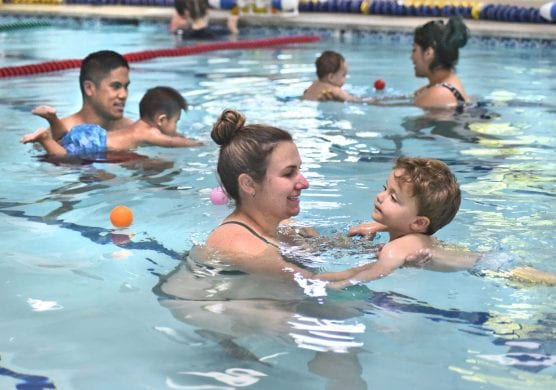As COVID-19 restrictions ease in Los Angeles County and swimming lessons resume just as summer begins, becoming familiar with water safety can make days spent by the pool more enjoyable.
“Swimming lessons are essential,” said Nikki Miller, president of Academy Swim Club in Santa Clarita. “It’s important, especially for children, even as young as 4 months, but it has to be taught the correct way, otherwise children develop a fear of water that stays with them throughout their lives.”
Drowning is the second-leading cause of death in children 14 years and younger, according to the Centers for Disease Control and Prevention, and the No. 1 cause of death in children younger than 5, according to Miller.
Very young children benefit
Swimming lessons can benefit children as young as a few months old, Miller said. She suggests parents find a program that works well for their children and, if necessary, find a different program or teacher if children seem hesitant after a few lessons.
“Listen to your children. If they’re scared, crying or screaming, don’t force them to swim,” Miller said. “That can cause a traumatic response where they’ll never be comfortable in water and don’t learn those life-saving skills.”
If a gathering has a pool nearby, designating a pool-watcher can decrease the chances of children falling into the pool, even if the pool is enclosed with a gate.
During swimming lessons, Miller said it’s common for instructors to dedicate a lesson to swimming in street clothes in case a child falls into a pool fully clothed.
“Swimming in a bathing suit is very different than falling into a pool with everyday clothes on,” she said. “That’s why programs will teach kids what to do if they fall into a pool and how to navigate safety with street clothes on.”
Wearing life jackets is always recommended for people in boats and participating in water sports, regardless of swim skills. Swim aids such as float wings or floating rings can help those in water to float at the surface, but won’t necessarily prevent drowning.
Learning to float
As part of swimming programs, learning to float on the surface of water is an important skill to learn in regards to water safety, and can be taught to infants as young as 4 months old, according to Miller.
Although floating is a skill taught in most swimming programs, parents should seek specialists when it comes to training infants to float, Miller said, adding that infants’ buoyancy and bodies are different than those of older children and requires special lessons.
“Babies have a floating reflex, which is shown as early as 4 months,” Miller said. “But it’s important to have an expert teach infants how to use this reflex so they can make sure the babies take a breath before being submerged in water.”
Miller also added it’s important to have an expert give infants swimming lessons because they can train infants to grab onto surfaces that are above the water, like the side of a pool.
Don’t swim alone
It’s beneficial to swim with a partner instead of alone to prevent mishaps, or choose a swimming area with a trained lifeguard on duty who can administer CPR if necessary. It’s beneficial for those who have pools at home or frequently visit beaches and lakes to learn CPR, as well.
The more quickly CPR is administered to someone who was drowning can significantly change the outcome, even before first responders arrive to the scene.
Miller stressed the importance of swimming lessons in children, but added that the past year of pandemic-related quarantine can cause children to be hesitant when it comes to instructors, and added a way to alleviate the hesitancy is for the parents to engage with their children during lessons, even if that means to take the instructor’s place.
“Since kids have been distancing from people for so long, it might be necessary for parents to intervene since physical distancing can be hard to do in a swim-lesson setting,” Miller said. “Maybe a parent will need to get in the water and take instructions from the teacher a few times so children can get used to it.”
Miller also said the pandemic can cause children to be at different swim levels, especially if children have pools at home and were able to practice. When looking for a swimming program that fits children’s needs, Miller said that is something to take into consideration as well.
“A good program will take notice of kids’ different levels of swimming and go at a pace that works for the child,” she said.
A final tip by Miller for those entering swim programs is to keep lessons to, at most, three times a week.
“If kids are constantly having to worry about going to swim class, it’s going to become a burden,” Miller said. “Kids will progress with time, but it’s an important skill to learn, so you don’t want to discourage children and make it unenjoyable.”
Like this:
Like Loading...
Related





 Tweet This
Tweet This Facebook
Facebook Digg This
Digg This Bookmark
Bookmark Stumble
Stumble RSS
RSS


























REAL NAMES ONLY: All posters must use their real individual or business name. This applies equally to Twitter account holders who use a nickname.
0 Comments
You can be the first one to leave a comment.